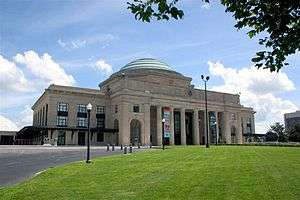Broad Street Station (Richmond)
Broad Street Station (originally Union Station) was a union railroad station in Richmond, Virginia, United States, across Broad Street from the Fan district. The building is now used by the Science Museum of Virginia.
Broad Street Station | ||||||||||||||||||||||||||||
|---|---|---|---|---|---|---|---|---|---|---|---|---|---|---|---|---|---|---|---|---|---|---|---|---|---|---|---|---|
| Former Atlantic Coast Line and Amtrak station | ||||||||||||||||||||||||||||
 | ||||||||||||||||||||||||||||
| Location | 2500 West Broad Street Richmond, Virginia 23220[1] | |||||||||||||||||||||||||||
| Coordinates | 37.561111°N 77.465833°W | |||||||||||||||||||||||||||
| Tracks | 3 (remaining) | |||||||||||||||||||||||||||
| History | ||||||||||||||||||||||||||||
| Opened | 1917 | |||||||||||||||||||||||||||
| Closed | 1975 (for passenger rail service) | |||||||||||||||||||||||||||
| Former services | ||||||||||||||||||||||||||||
| ||||||||||||||||||||||||||||
Broad Street Station | ||||||||||||||||||||||||||||
| Architect | John Russell Pope | |||||||||||||||||||||||||||
| NRHP reference No. | 72001518[2] | |||||||||||||||||||||||||||
| VLR No. | 127-0226 | |||||||||||||||||||||||||||
| Significant dates | ||||||||||||||||||||||||||||
| Added to NRHP | February 23, 1972 | |||||||||||||||||||||||||||
| Designated VLR | November 16, 1971[3] | |||||||||||||||||||||||||||
History
.jpg)
It was built as the southern terminus for the Richmond, Fredericksburg and Potomac Railroad (RF&P) in 1917 in the neoclassical style by the architect John Russell Pope. The station also served the trains of the Atlantic Coast Line Railroad (ACL) and Norfolk and Western Railway (N&W). Eventually, the Seaboard Air Line Railroad (SAL), which had formerly used Richmond's other union station, Main Street Station, switched to Broad Street Station.
At Amtrak's inception in 1971, it was served by the Champion, Silver Meteor, and Silver Star (all inherited from the Seaboard Coast Line Railroad, successor to ACL and SAL), [4] and the Southern Railway's Asheville Special. It was added to the National Register of Historic Places on February 23, 1972.
Passenger service to the station ceased in 1975, when Amtrak consolidated all Richmond-area service at a suburban station on Staples Mill Road, north of downtown. By 1976, Broad Street Station became the new home of the Science Museum of Virginia, which remains in the substantially remodeled and expanded building.
References
- "All-American Schedules". timetables.org. Amtrak. 29 Apr 1973. p. 8. Retrieved 12 Jan 2014.
- "National Register Information System". National Register of Historic Places. National Park Service. April 15, 2008.
- "Virginia Landmarks Register". www.dhr.virginia.gov. Virginia Department of Historic Resources. Archived from the original on 2013-09-21. Retrieved 19 Mar 2013.
- "All-American Schedules". timetables.org. Amtrak. 15 Nov 1974. pp. 38–39. Retrieved 12 Jan 2014.

